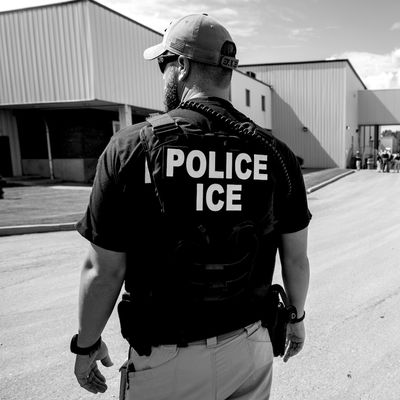
On Monday news spread that women in a Georgia ICE detention center are being coerced into hysterectomies, according to a whistleblower and former nurse at the facility. The stories, collected in a complaint filed by the nonprofit Project South, are horrific: women describe one gynecologist, Mahendra Amin, giving them the surgery without proper explanation, being yelled at by nurses when they resisted the procedure, and feeling like the medical staff were “experimenting with our bodies.”
It might seem shocking and ripped from the pages of a dystopian novel that in 2020, immigrant women are having their reproductive organs removed without their full consent. But in America, it’s nothing new: The U.S. has a long, dark history of inflicting these forced operations on the most vulnerable groups of people, and this type of abuse still happens in jails, prisons and detention centers.
From the early 20th century to the 1970s, up to 70,000 Americans – most of them women – were forcibly sterilized. They were deemed unfit to procreate because of eugenics, the concept that certain people are tainted by undesirable traits that should be bred out of future generations. “Undesirable,” of course, was a euphemism for immigrants and anyone non-white, poor, mentally ill or who had disabilities. (In some cases, it included women who were “promiscuous.”) The belief that only white, privileged offspring were welcome in America led to federally-funded sterilization programs in 32 states, and a landmark Supreme Court case from 1927 reaffirmed the idea that governments should control who gets to have kids.
The lawsuit involved a 20-year-old woman named Carrie Buck, who had gotten pregnant three years earlier after being raped. She was poor and the state of Virginia had deemed her “feebleminded” — common shorthand at the time for unintelligent, mentally ill or licentious women — and decided that she was a prime candidate for a newly enacted involuntary sterilization law. When Buck legally challenged the operation, a Supreme Court judge ruled against her, explaining that her “feeblemindedness” and “promiscuity” was inherited from her mother and would be passed on to any offspring. (“Three generations of imbeciles are enough,” he said.)
By that time, some states had even created eugenics boards with committee members who would read petitions from government agencies or family members and order sterilizations. North Carolina’s board was one of the most aggressive: the state performed surgeries on more than 7,600 people between the 1930s and 1970s, 65% of whom were Black women. American politicians only distanced themselves from eugenics after the term was embraced by the Nazis — Hitler cited U.S. law as inspiration — but forced sterilizations continued with a rebranded logic.
By the 1940s, the justifications for these surgeries shifted slightly, with defenders now claiming that the procedure would save the government welfare money and pull women out of poverty. But the targets remained the same: Black women, immigrants and people with disabilities. And the ways in which these vulnerable groups were exploited and taken advantage of echo the stories of the women in ICE detention today.
During the same time that Roe v. Wade granted mostly white women more bodily autonomy in the 1970s, up to 50% of Native American women were forcibly sterilized by the U.S. government. Doctors from the Indian Health Service (IHS) didn’t believe these women were intelligent enough to use birth control, and doctors coerced them into signing consent forms or gave them misleading information. Many drank themselves to death when they found out they had been sterilized.
Those coerced into forced sterilizations lacked the resources to fight for or understand their rights. Politicians and doctors took authority over vulnerable women’s bodies, and stripped them of any decision-making power or due process. Poor Black women were subjected to a disproportionate number of operations. A high-profile case from the 1970s focused on two sisters from Alabama — 12 and 14 — who were secretly sterilized by a federally-funded clinic. (Their mother, who was illiterate, had signed a form that she thought gave her daughters permission to get birth control.) Hospitals in the South let medical students practice unnecessary hysterectomies on Black women, in what came to be known as “Mississippi appendectomies” and a third of those sterilizations were done on girls under 18.
Doctors always sought out the most at-risk women and gave them little information. Women woke up from forced surgeries confused. Many victims of these operations lived in psychiatric institutions and received no warning about the procedure. A court document described the reason a 14-year-old Black teenager was sterilized in North Carolina: “Final diagnoses: Mental retardation, severe.” (In some states, the non-consensual sterilization of people with intellectual disabilities is still legal in certain cases.)
The ultimate goal of eugenics is to keep immigrants out of the U.S., and to curb their ability to procreate within the country. It’s no surprise that the worst offending state for forced sterilizations was California, a place with a large Latinx and Asian population, where roughly 20,000 people had operations that left them barren between 1909 and 1964. Over the next 10 years, hundreds of Mexican American women were sterilized under duress while giving birth at a county hospital in Los Angeles.
In the documentary No Más Bebés the women say that nurses and doctors threatened to withhold painkillers or emergency caesarian sections — telling them “your baby could probably die” — if they didn’t sign consent forms. They scrawled signatures in moments of confusion and desperation, only realizing after the fact that their reproductive rights were now gone. Between the 1930s and 1970s, roughly a third of Puerto Rico’s population was sterilized — the highest rate in the world — and the procedure became so common that doctors referred to it simply as “la operación.”
While most instances of forced sterilizations are now illegal — a Supreme Court ruling in the late 1970s said doctors had to fully inform patients of their rights and could not ask for consent during childbirth — the practice continues. It’s most common for people who are incarcerated or detained, like the women who say they were coerced into hysterectomies while in ICE custody. Between 1997 and 2010, 1,400 women in California prisons were given unwanted sterilizations — one doctor said it would save welfare money going towards unwanted children — even though the forced surgeries were officially banned in the state in 1979. And as recently as 2017, a Tennessee judge told repeat offenders that he would cut down their jail time if they volunteered to have surgeries or contraceptive implants that would stop them from procreating.
The whistleblower complaint about detained women has sparked mass outrage online. Politicians like Rep. Ayanna Pressley (D-Mass.) and Rep. Pramila Jayapal (D-Wash.) are calling for a congressional investigation into the issue of coercive hysterectomies and hopefully the Trump administration and the doctor involved will be held accountable. But the appalling allegations are further proof that the centuries-old tradition of exploiting vulnerable, BIPOC women’s bodies is still alive and well in America.





